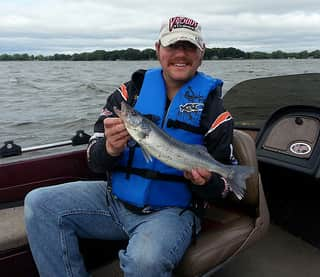Wisconsin Angler Catches Rare Blue Walleye on Lake Winnebago
OutdoorHub 08.01.13

Dan Small Outdoors
dsmallwrtr@aol.com
920-994-4082
Wisconsin angler catches rare blue walleye
By Dan Small
Jeff Kelm would be the first to admit he is not the world’s best walleye fisherman. The Sheboygan native, a professional angler who represented the U.S. at two World Ice Fishing Championships, is more comfortable catching panfish through the ice or – his latest passion – European-style bank fishing for carp.
Imagine his surprise, then, when he caught a rare blue-phase walleye on Lake Winnebago on July 27.
Kelm was fishing north of Van Dyne in four feet of water along the lake’s west shore with John McArdle, of Fond du Lac, when he caught the blue walleye. The fish hit an orange jig tipped with half a crawler – standard fare for summer walleyes on the 130,000-acre lake. One of four walleyes Kelm and McArdle caught that day, the 18-inch blue walleye was was anything but standard, however.
Kelm called Wisconsin DNR Lake Winnebago fisheries biologist Kendall Kamke, who told him the fish was indeed very rare.
“I’ve seen only one myself, but I hear about a blue-phase walleye, perch or northern pike coming from the lake every-other year or so,” Kamke said.
Although they are still uncommon in Wisconsin waters, blue-phase walleyes have also been found in Minnesota, Michigan’s Upper Peninsula, New York and Vermont in recent years, according to UW-Washington County biology professor Wayne Schaefer. Schaefer, who has studied blue walleyes in Ontario and western Quebec for more than 15 years, says the blue phase is appearing farther south for some yet-unknown reason.
“Blue walleyes are fairly common in several lakes near Ear Falls, Ontario,” Schaefer said. “Several outfitters up there can pretty much guarantee you’ll catch one.”
Some blue walleyes, like the one Kelm caught, simply lack the yellow pigmentation found in most walleyes. Others also produce a blue pigment, called Sandercyanin, which is clearly evident in slime scraped off the back of the fish. The University of Wisconsin has applied for a patent on a clone of this blue pigment and hopes to make it available for use in medical research.
“Color variation in walleyes is fairly common, but to find one with no yellow pigment is really unusual,” Schaefer said. “And one with Sandercyanin pigmentation more unusual still.”
Although Kelm’s blue walleye is the perfect “eater” size, he has no plans to fillet it.
“This one’s going on the wall,” he said. “I catch so few of them anyway, but it’s a safe bet I’ll never catch another blue one.”
For more information on blue walleyes and Schaefer’s research, visit www.bluewalleye.com. Schaefer would like to hear of any other blue walleyes caught in Wisconsin waters or elsewhere.
– 30 –

